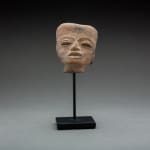Teotihuacan Terracotta Fragment of a Head, 200 CE - 750 CE
Terracotta
6 x 5.1 cm
2 3/8 x 2 1/8 in
2 3/8 x 2 1/8 in
PF.3041
Further images
After 250 A.D. objects made from clay increased dramatically in Teotihuacan, serving a wide variety of purposes and functions. This intriguing head was once attached to a bust or full...
After 250 A.D. objects made from clay increased dramatically in Teotihuacan, serving a wide variety of purposes and functions. This intriguing head was once attached to a bust or full figure, and therefore was probably either a host figurine or "puppet". Both categories of figures were found in burials and caches. The host figurine commemorated important events within the city of Teotihuacan and other parts of Mesoamerica, portraying individuals of different rank and status (such as soldiers, merchants or bureaucrats), and occasionally divinities. Puppets, or articulated figurines, constitute a fascinating group of clay objects with moveable limbs. The slight indentation, or cleft of the head, and the flattened face are characteristic of puppet faces, most of which are female. This head's slightly parted mouth and half-closed eyes give the impression of someone in a trance or hallucinogenic state. It's beauty comes from the delicate curves of the face, the high forehead, carefully modeled features, and a mysterious quality.







